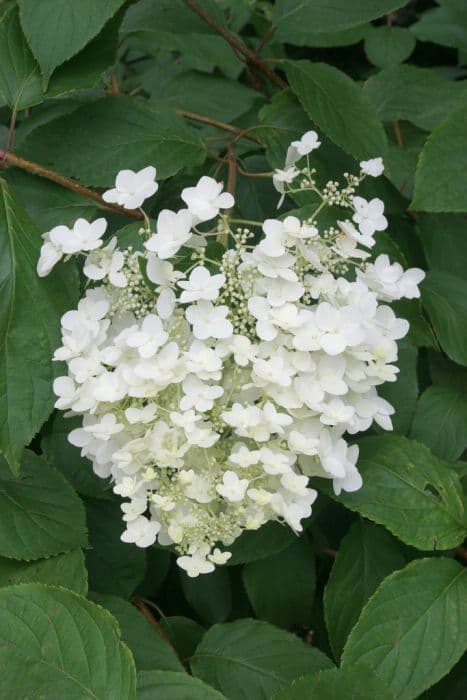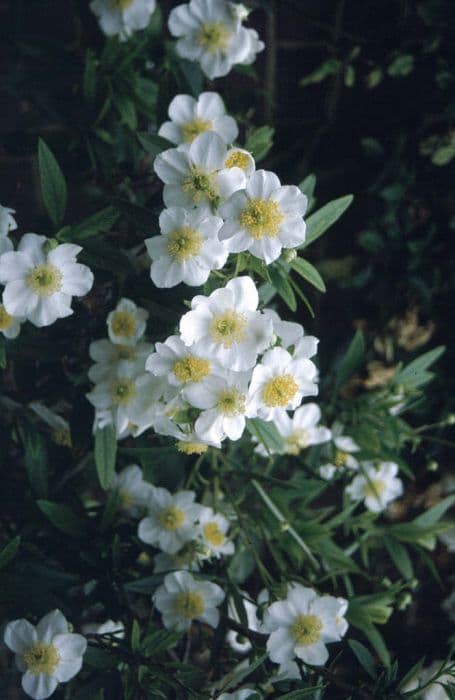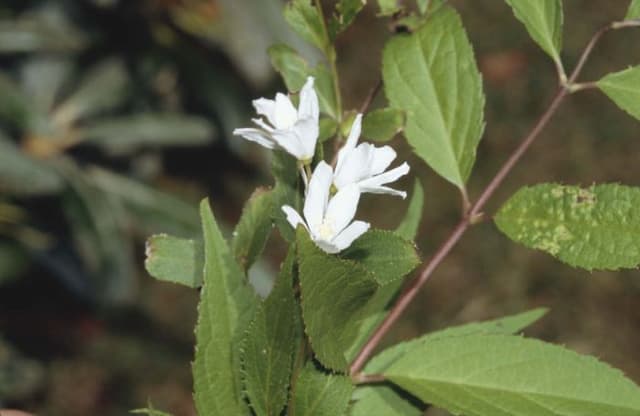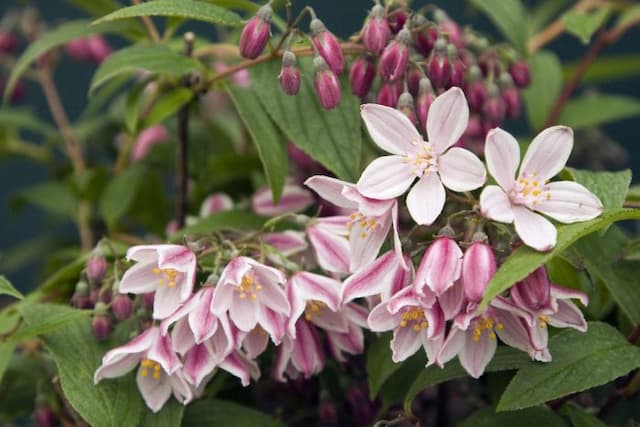Paniculate hydrangea 'White Moth' Hydrangea paniculata 'White Moth'

ABOUT
A large, deciduous shrub, to 4m tall and wide, with ovate, serrated leaves. The flowerheads are rounded and up to 14cm in diameter; the small white fertile flowers are surrounded by white ray florets that age to pale green and are carried on long stalks
About this plant
 Names
NamesFamily
Hydrangeaceae
Synonyms
Panicle Hydrangea, Peegee Hydrangea, White Moth Hydrangea
Common names
Hydrangea paniculata 'White Moth'.
 Characteristics
CharacteristicsLife cycle
Perennials
Foliage type
Deciduous
Color of leaves
Green
Flower color
White
Height
8-15 feet (2.4-4.6 meters)
Spread
6-10 feet (1.8-3 meters)
Plant type
Shrub
Hardiness zones
3-8
Native area
Japan China
Benefits
 General Benefits
General Benefits- Ornamental value: The panicle hydrangea 'White Moth' offers striking white flowers that can add aesthetic appeal to gardens and landscapes.
- Seasonal interest: This plant blooms in late summer to fall, providing interest during a time when many other plants have finished flowering.
- Adaptability: Panicle hydrangeas are adaptable to a range of soil conditions, although they prefer well-drained soil.
- Hardiness: They are cold hardy and can thrive in USDA Hardiness Zones 3 through 8, making them suitable for many climates.
- Low maintenance: Once established, they require minimal care beyond occasional pruning and watering during dry periods.
- Attracts pollinators: The flowers attract bees, butterflies, and other pollinators, supporting local ecosystems.
- Versatility in landscaping: Can be planted as a standalone specimen, in groups, or as part of a mixed border.
 Medical Properties
Medical PropertiesThis plant is not used for medical purposes.
 Air-purifying Qualities
Air-purifying QualitiesThis plant is not specifically known for air purifying qualities.
 Other Uses
Other Uses- Hedge or Privacy Screen: Hydrangeas can grow quite large, and when planted in a row, they can create a lush and beautiful living fence for privacy or to delineate property lines.
- Photography Backdrop: The fullness and striking white blooms of Hydrangea offer an ideal backdrop for outdoor portrait photography or nature photography.
- Erosion Control: With their extensive root systems, Hydrangeas can help prevent soil erosion in hilly or sloped areas of a garden or landscape.
- Dried Floral Arrangements: The flowers of Hydrangeas can be dried and used in floral arrangements, providing a long-lasting display of their beauty.
- Theme Gardens: Hydrangea can be a central element in thematic gardens, such as a white garden that features flowers of only white coloration.
- Culinary Garnish: Although not commonly known for edible qualities, the blooms can potentially be used as a decorative, non-toxic garnish on certain dishes for special occasions.
- Art Inspiration: The intricate patterns of Hydrangea flowers make them a popular subject for artists, inspiring paintings, textiles, and decorative designs.
- Wedding Decor: Due to their full and opulent blooms, Hydrangeas are often used in wedding bouquets, centerpieces, and venue decorations.
- Teaching Tool: Educators can use Hydrangeas to teach botany concepts, such as flower anatomy and plant lifecycle, as their size and structure make it easy to identify different plant parts.
- Attracting Wildlife: Hydrangeas can attract pollinators like bees and butterflies, contributing to the local ecosystem and promoting biodiversity.
Interesting Facts
 Feng Shui
Feng ShuiThe Panicled Hydrangea is not used in Feng Shui practice.
 Zodiac Sign Compitability
Zodiac Sign CompitabilityThe Panicled Hydrangea is not used in astrology practice.
 Plant Symbolism
Plant Symbolism- Heartfelt Emotions - Hydrangeas often symbolize the expression of deep and heartfelt emotions. The 'White Moth' variety, with its pristine white flowers, could be seen to represent purity or intensity of these feelings.
- Gratitude - The generous blooms and the fullness of the hydrangea symbolize gratitude and thanksgiving, making the 'White Moth' a good choice for expressing appreciation.
- Understanding - In certain cultures, hydrangeas are given to express understanding or an apology, possibly making 'White Moth' a flower of reconciliation.
- Vanity - Historically, hydrangeas have also been associated with vanity and boastfulness due to their showy and abundant blossoms, which might carry into the symbolism of the 'White Moth' hydrangea as well.
- Abundance and Prosperity - The lush, full nature of hydrangea blooms is often linked with abundance and prosperity, relating to the fullness of life’s experiences.
 Water
WaterFor the PeeGee hydrangea, which is the common name for Hydrangea paniculata 'White Moth', water deeply once a week, providing about 1 gallon of water per plant if rainfall doesn't suffice. During the first growing season, establishing a strong root system requires consistent moisture, so increase watering to twice a week if conditions are particularly hot or dry. Reduce watering to every other week in cooler weather or when rainfall is adequate. Ensure that the soil is well-draining to prevent root rot. Avoid overhead watering to minimize the risk of leaf diseases, instead focus on the base of the plant.
 Light
LightThe PeeGee hydrangea thrives in an area with full sun to partial shade. It's best positioned where it will receive at least 4 hours of direct sunlight with some afternoon shade in hotter climates to prevent scorching. They can bloom in more shaded areas, but flowering may be less prolific. Good morning sunlight is especially beneficial to help dry dew on the leaves and reduce the risk of fungal diseases.
 Temperature
TemperaturePeeGee hydrangeas are cold-hardy and can tolerate a range of temperatures. They are capable of withstanding winter temperatures as low as -20 degrees Fahrenheit, but the ideal growing conditions are between 60 to 75 degrees Fahrenheit. Summer heat should not be an issue as long as the plant receives adequate water, but it's best situated in a location where it is protected from the harsh afternoon sun in regions with extreme summer temperatures.
 Pruning
PruningThe PeeGee hydrangea should be pruned in late winter or early spring before new growth starts. Remove about one-third of the total height to encourage strong stems and larger flower heads. Pruning can also be done immediately after flowering if you want to shape the plant or remove spent blooms. It's not necessary to prune every year, but annual pruning helps maintain a manageable shape and promotes the health of the plant.
 Cleaning
CleaningAs needed
 Soil
SoilThe panicled hydrangea 'White Moth' thrives best in a moist, well-draining loamy soil with abundant organic matter. A pH range of 5.5 to 6.5 is ideal to maintain healthy growth. A mixture of garden soil, peat moss, and compost will create favorable conditions for this plant.
 Repotting
RepottingPanicled hydrangeas like 'White Moth' typically require repotting every 3 to 5 years. However, if the plant is growing vigorously and becomes root-bound or the soil quality degrades, it may need repotting more frequently.
 Humidity & Misting
Humidity & MistingPanicled hydrangea 'White Moth' prefers consistently high humidity levels, ideally between 50% to 60%. Maintaining these conditions will support its lush foliage and robust blooms.
 Suitable locations
Suitable locationsIndoor
Ensure bright, indirect light and room to grow.
Outdoor
Find part-sun spot; protect from harsh afternoon sun.
Hardiness zone
3-8 USDA
 Life cycle
Life cycleThe life of Hydrangea paniculata 'White Moth', commonly known as Peegee Hydrangea, begins with seed germination, which occurs in the spring when soil temperatures warm up. Following germination, the seedling emerges and develops into a young plant with a set of true leaves, and over time it grows larger, establishing a sturdy root system. In its juvenile phase, the hydrangea focuses on vegetative growth, expanding both its root and shoot systems. Upon reaching maturity, which can take several years, the plant begins its reproductive phase, producing large, conical flower clusters that start white and may turn pinkish as they age, usually blooming in mid to late summer. After pollination and fertilization, seeds are produced and dispersed in the fall, and the plant enters a period of dormancy during the winter months. The Peegee Hydrangea's life cycle can repeat annually for many years, with the plant capable of living several decades under favorable conditions.
 Propogation
PropogationPropogation time
Late Winter to Early Spring
Propogation: Hydrangea paniculata 'White Moth', commonly known as the panicled hydrangea, is typically propagated by softwood cuttings. This method is best performed during late spring or early summer when the plant's new growth is still tender and green but has not yet matured or turned woody. To propagate by softwood cuttings, gardeners should select healthy shoots that have no flowers, cutting lengths of about 5 to 6 inches (approximately 12.7 to 15.2 centimeters). Leaves near the bottom of the cutting should be removed, and the cut end is often dipped in a rooting hormone to encourage root development. Cuttings are then placed in moist potting soil or a mixture of peat and perlite, ensuring that at least two sets of leaf nodes are submerged. The cuttings should be kept in a warm, humid environment with indirect sunlight, being careful to maintain soil moisture without saturation. Roots typically form within a few weeks, at which point the new hydrangea plants can gradually acclimate to outdoor conditions.








![Hydrangea [Strong Annabelle]](/_next/image?url=https%3A%2F%2Fplants-admin.emdemapps.com%2Fimages%2Fplants%2F%2Fimages%2F604b54db37d34.png&w=640&q=75)
